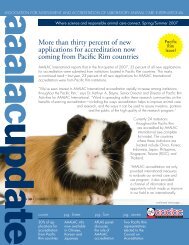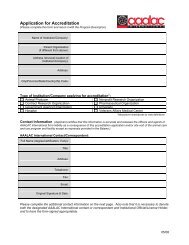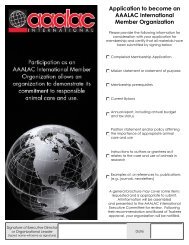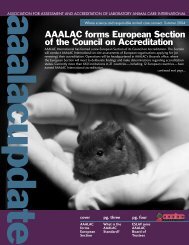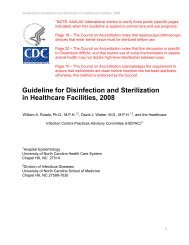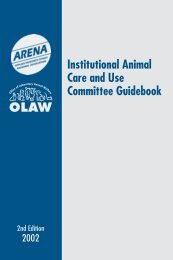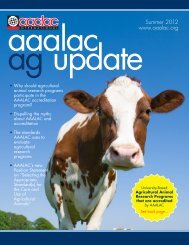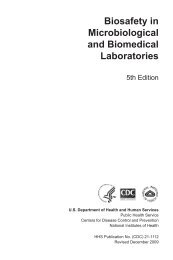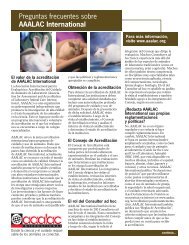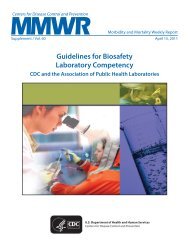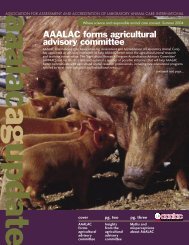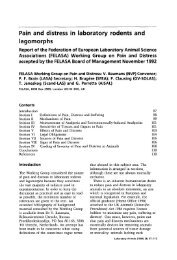Medical Records for Animals Used in Research, Teaching ... - Aaalac
Medical Records for Animals Used in Research, Teaching ... - Aaalac
Medical Records for Animals Used in Research, Teaching ... - Aaalac
You also want an ePaper? Increase the reach of your titles
YUMPU automatically turns print PDFs into web optimized ePapers that Google loves.
desired outcome of provid<strong>in</strong>g the highest quality of careavailable.ACLAM Position on <strong>Medical</strong> <strong>Records</strong>Content and ScopeEstablish<strong>in</strong>g and ma<strong>in</strong>ta<strong>in</strong><strong>in</strong>g appropriate medical records isa core component of adequate veter<strong>in</strong>ary care [AVMA2002; Gaertner 2003]. <strong>Medical</strong> records provide documentationof the care given, and communicate that <strong>in</strong><strong>for</strong>mation toother professionals [APHIS 2000; CFR 2003; Osborne1983]. <strong>Medical</strong> record <strong>in</strong><strong>for</strong>mation may be reta<strong>in</strong>ed <strong>in</strong> amedical record and/or research record, depend<strong>in</strong>g on howthe <strong>in</strong>stitution wishes to run its program.The <strong>in</strong>stitution, under the guidance of the Attend<strong>in</strong>gVeter<strong>in</strong>arian, should determ<strong>in</strong>e the method(s) by whichmedical records are ma<strong>in</strong>ta<strong>in</strong>ed. <strong>Medical</strong> records may takemany <strong>for</strong>ms [Hask<strong>in</strong>s and Eisele 1997] and have severalcomponents, such as written records, computerized records,sent<strong>in</strong>el animal reports, cl<strong>in</strong>ical pathology reports, qualityassurance reports, cage cards, and animal disposition reports.These components can be <strong>in</strong>cluded <strong>in</strong> the medicaland/or research record, or can be l<strong>in</strong>ked and available. Themethod of record keep<strong>in</strong>g should be designed to fit thespecific needs of each program of veter<strong>in</strong>ary care.Oversight of the medical records must fall under thedirection of the Attend<strong>in</strong>g Veter<strong>in</strong>arian or his/her designeeand the IACUC. Individuals typically responsible <strong>for</strong> mak<strong>in</strong>gnotations <strong>in</strong> medical records <strong>in</strong>clude veter<strong>in</strong>ary staff(veter<strong>in</strong>arians and/or veter<strong>in</strong>ary technicians), animal husbandrystaff (animal care staff, managers, supervisors), andresearch staff (e.g., pr<strong>in</strong>cipal <strong>in</strong>vestigators, study directorsand/or research technicians).The ACLAM recognizes that many research animals,particularly rodents, can be obta<strong>in</strong>ed and ma<strong>in</strong>ta<strong>in</strong>ed <strong>in</strong> astate of good health, without the necessity of a medicalrecord be<strong>in</strong>g created. When medical records <strong>for</strong> such animalsare <strong>in</strong>dicated, group records may be acceptable andmay be more efficient than <strong>in</strong>dividual records [FASS 1999].Individual medical records should be ma<strong>in</strong>ta<strong>in</strong>ed <strong>for</strong> animalsthat receive regular <strong>in</strong>dividual health evaluations, asdeemed appropriate by the <strong>in</strong>stitution [Suckow and Doern<strong>in</strong>g2000].When a medical record is created, the <strong>in</strong><strong>for</strong>mationshould be recorded so that the care and course of treatment<strong>for</strong> animals can be reconstructed, if necessary [Lees 1981].The medical record should also conta<strong>in</strong> a sufficient amountof detail to determ<strong>in</strong>e the research use of the animal. However,cl<strong>in</strong>ical notations related to a disease that is experimentally<strong>in</strong>duced <strong>in</strong> animals do not necessarily need to bema<strong>in</strong>ta<strong>in</strong>ed <strong>in</strong> the medical record. Rather, it may be appropriate<strong>for</strong> this <strong>in</strong><strong>for</strong>mation to be reta<strong>in</strong>ed with<strong>in</strong> researchrecords, but the <strong>in</strong><strong>for</strong>mation must be readily available <strong>for</strong>review by the veter<strong>in</strong>ary staff, as well as <strong>for</strong> appropriate<strong>in</strong>ternal (e.g., IACUC) or external (e.g., USDA) oversightuses.Components of a <strong>Medical</strong> RecordWhen <strong>in</strong>stitutional representatives determ<strong>in</strong>e that a medicalrecord should be created, the record typically conta<strong>in</strong>s thefollow<strong>in</strong>g types of <strong>in</strong><strong>for</strong>mation [APHIS 2000; NRC 1996]:1. Identification of the animal(s) or group(s),2. Cl<strong>in</strong>ical <strong>in</strong><strong>for</strong>mation such as results of physical exam<strong>in</strong>ation,the behavior of the animal, and notations regard<strong>in</strong>gobserved abnormalities, illnesses, and/or<strong>in</strong>juries,3. Immunizations and other prophylactic treatments andprocedures as appropriate <strong>for</strong> the species,4. Documentation of diagnostic tests and <strong>in</strong>terpretation,5. Reference to the research <strong>in</strong>tervention, whereappropriate,6. Treatment prescribed and provided, the cl<strong>in</strong>ical response,and follow up,7. Surgery, anesthesia, analgesia and peri/post-operativecare,8. Control of pa<strong>in</strong> and distress,9. Documentation of euthanasia or other disposition,10. Documentation of necropsy f<strong>in</strong>d<strong>in</strong>gs, if <strong>in</strong>dicated.<strong>Medical</strong> records should be written to def<strong>in</strong>e and reflectthe current level of understand<strong>in</strong>g of a health problem[FASS 1999]. The record should be ref<strong>in</strong>ed as additional<strong>in</strong><strong>for</strong>mation is acquired, and communicate the medical logicand case progression [Chavis and Hutton 1998; Lees 1981].Notations <strong>in</strong> the medical record should be made by <strong>in</strong>dividualswho have adm<strong>in</strong>istered treatments, or made directobservations or evaluations of the animal(s) or their diagnosticresults, or their designee. Individuals typically responsible<strong>for</strong> mak<strong>in</strong>g notations <strong>in</strong> the record <strong>in</strong>cludeveter<strong>in</strong>ary staff (veter<strong>in</strong>arians and/or veter<strong>in</strong>ary technicians),animal husbandry staff (animal care staff, managers,supervisors), and research staff (e.g., pr<strong>in</strong>cipal <strong>in</strong>vestigators,study directors and/or research technicians). All entries <strong>in</strong>the record should be dated, <strong>in</strong>dicate the orig<strong>in</strong>ator of theentry (e.g., <strong>in</strong>itials, signature, and electronic signature) andbe legible to someone other than the writer [CareFirst 2004].Facilities may wish to consider establish<strong>in</strong>g a list thatsummarizes the animal’s medical history at a glance. Thismay be particularly valuable <strong>for</strong> animals that undergo amajor survival surgery and/or are reassigned to anotherproject. A copy of the medical record, or a pert<strong>in</strong>ent summaryof that animal’s medical history, should follow theanimal upon reassignment [APHIS 2000].Types of <strong>Medical</strong> <strong>Records</strong>A. Individual Health <strong>Records</strong>Individual health records should be ma<strong>in</strong>ta<strong>in</strong>ed <strong>for</strong> animalsthat receive regular <strong>in</strong>dividual health evaluations, asdeemed appropriate by the <strong>in</strong>stitution [Hask<strong>in</strong>s and EiseleVolume 48, Number 1 2007 39



